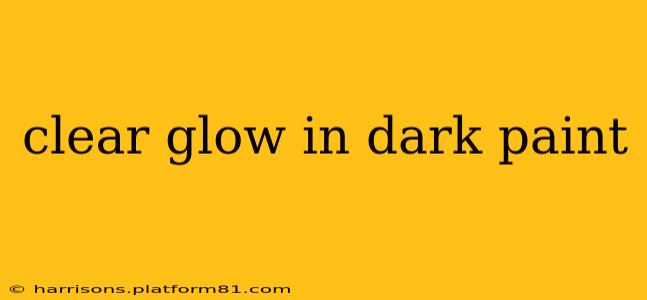Glow-in-the-dark paint, also known as phosphorescent paint, offers a magical touch to various projects, from crafting and decorating to creating unique visual effects. However, achieving a truly clear glow can be tricky. Many glow-in-the-dark paints appear slightly opaque or tinted, even when dry. This article explores the nuances of clear glow-in-the-dark paint, addressing common questions and providing tips for achieving the best results.
What Makes Glow-in-the-Dark Paint Glow?
Glow-in-the-dark paint contains phosphors, which are special materials that absorb energy from light sources (like sunlight or UV light) and then slowly release that energy as light over time. The brightness and duration of the glow depend on the type and quality of the phosphor used. Higher-quality paints use more efficient phosphors, resulting in a brighter and longer-lasting glow. The clarity, or lack thereof, is often influenced by the binding agents and other additives mixed with the phosphor.
How Can I Make Glow-in-the-Dark Paint Clearer?
This is a common challenge. Many commercially available paints, even those marketed as "clear," can have a slightly cloudy or tinted appearance. Here are several approaches to enhance the clarity:
-
Choose a high-quality paint: Opt for paints specifically designed for maximum brightness and clarity. Read reviews carefully, focusing on comments about the paint's transparency.
-
Apply thin coats: Multiple thin coats are better than one thick coat. Thick coats are more likely to appear opaque and reduce the glow's intensity. Let each coat dry completely before applying the next.
-
Use a clear base coat: Applying a clear acrylic or varnish as a base coat before applying the glow-in-the-dark paint can sometimes improve clarity and prevent the glow paint from absorbing into the surface. This is especially helpful on porous materials like wood.
-
Experiment with different brands and types: Different manufacturers use different formulations, leading to variations in clarity. Experimenting with a few different brands might help you find one that meets your needs. Consider paints specifically designed for glass or other transparent surfaces.
Is There Truly Clear Glow-in-the-Dark Paint?
While achieving perfect, absolute clarity is challenging, some brands produce glow paints that are significantly clearer than others. The term "clear" is often relative; there might be a very slight tint, but it won't significantly detract from the glow or the overall appearance when applied thinly.
What Surfaces Work Best with Clear Glow-in-the-Dark Paint?
Clear glow-in-the-dark paint works best on smooth, non-porous surfaces. These surfaces allow the light to pass through more easily, maximizing the visibility of the glow. Good choices include glass, acrylic, and smooth plastics. Porous surfaces like wood or fabric will absorb the paint, potentially reducing the glow and clarity.
How Long Does Clear Glow-in-the-Dark Paint Glow?
The duration of the glow depends on several factors: the quality of the phosphor, the intensity of the charging light source, and the environmental conditions (temperature and humidity). Generally, expect a glow that lasts from several minutes to several hours, depending on these factors.
Can I Mix Clear Glow-in-the-Dark Paint with Other Paints?
You can mix glow-in-the-dark paint with other paints, but keep in mind that this will significantly reduce the brightness and clarity of the glow. The more you dilute it, the weaker the glow becomes. If mixing, start with a small amount of glow paint to see how the color and glow intensity are affected.
By carefully selecting your paint and employing the techniques discussed above, you can dramatically improve the clarity of your glow-in-the-dark projects and achieve a beautifully luminous result. Remember that experimentation is key—what works best will depend on the specific paint and the surface you're working with.
